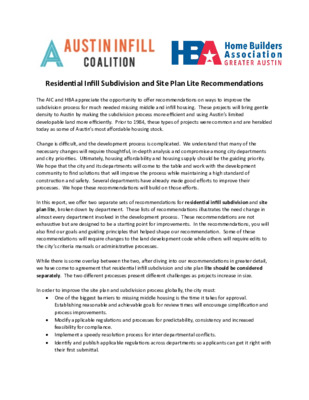14 Residential Infill Subdivision and Site Plan Lite Recommendations Executive Summary — original pdf
Backup

Residential Infill Subdivision and Site Plan Lite Recommendations The AIC and HBA appreciate the opportunity to offer recommendations on ways to improve the subdivision process for much needed missing middle and infill housing. These projects will bring gentle density to Austin by making the subdivision process more efficient and using Austin’s limited developable land more efficiently. Prior to 1984, these types of projects were common and are heralded today as some of Austin’s most affordable housing stock. Change is difficult, and the development process is complicated. We understand that many of the necessary changes will require thoughtful, in-depth analysis and compromise among city departments and city priorities. Ultimately, housing affordability and housing supply should be the guiding priority. We hope that the city and its departments will come to the table and work with the development community to find solutions that will improve the process while maintaining a high standard of construction and safety. Several departments have already made good efforts to improve their processes. We hope these recommendations will build on those efforts. In this report, we offer two separate sets of recommendations for residential infill subdivision and site plan lite, broken down by department. These lists of recommendations illustrates the need change in almost every department involved in the development process. These recommendations are not exhaustive but are designed to be a starting point for improvements. In the recommendations, you will also find our goals and guiding principles that helped shape our recommendation. Some of these recommendations will require changes to the land development code while others will require edits to the city’s criteria manuals or administrative processes. While there is some overlap between the two, after diving into our recommendations in greater detail, we have come to agreement that residential infill subdivision and site plan lite should be considered separately. The two different processes present different challenges as projects increase in size. In order to improve the site plan and subdivision process globally, the city must: • One of the biggest barriers to missing middle housing is the time it takes for approval. Establishing reasonable and achievable goals for review times will encourage simplification and process improvements. • Modify applicable regulations and processes for predictability, consistency and increased • • feasibility for compliance. Implement a speedy resolution process for inter departmental conflicts. Identify and publish applicable regulations across departments so applicants can get it right with their first submittal. • Reduce duplicative reviews during the subdivision process, recognizing that many items like trees are reviewed during the building permit review process. • Set goals to review and approve projects in timelines that are consistent with other large cities. • Streamline the subdivision process to allow for more homes to be built and sold fee-simple. • Refrain from regulating using interpretations from internal memos that are generally unavailable to the public. • More closely align reviews for identical projects, whether they are subdivided or utilize a condo regime. Identify and reconcile conflicting regulations in the criteria manuals. • • Reduce or eliminate the need for waivers and allow for flexibility to accommodate a variety of • Eliminate land dedication for right of way and allow for additional flexibility with utility housing on smaller sites. placement and easements. • Reduce required easements wherever possible and simplify the easement process to make it • Right-size water-quality and detention requirements for missing middle projects to preserve as consistent and fast across departments. much housing capacity as possible on site. This project is complicated and requires cross-departmental collaboration managed by the city manager’s office. We suggest that the city consider hiring an outside consultant to facilitate the discussion and ensure that stakeholders and practitioners are engaged throughout the process. We encourage the city to explore other cities to find solutions that work well outside of Austin.